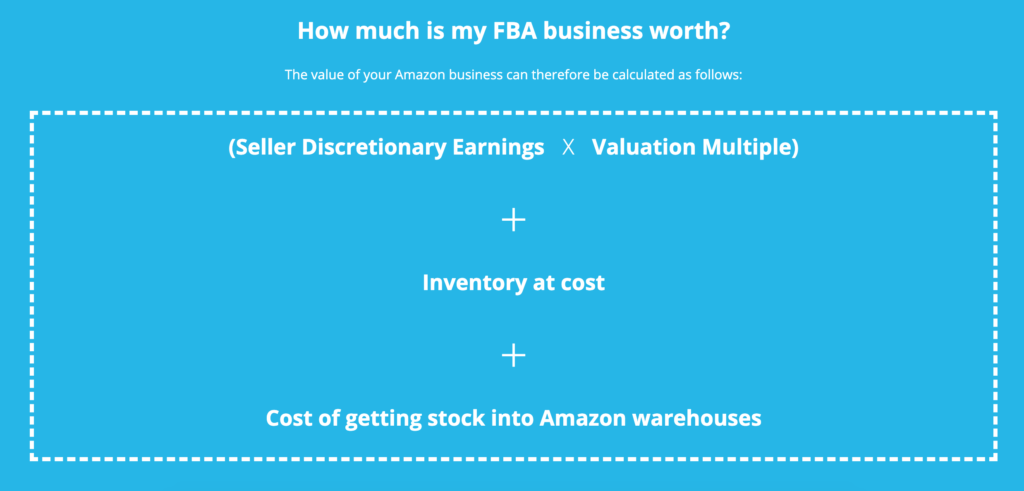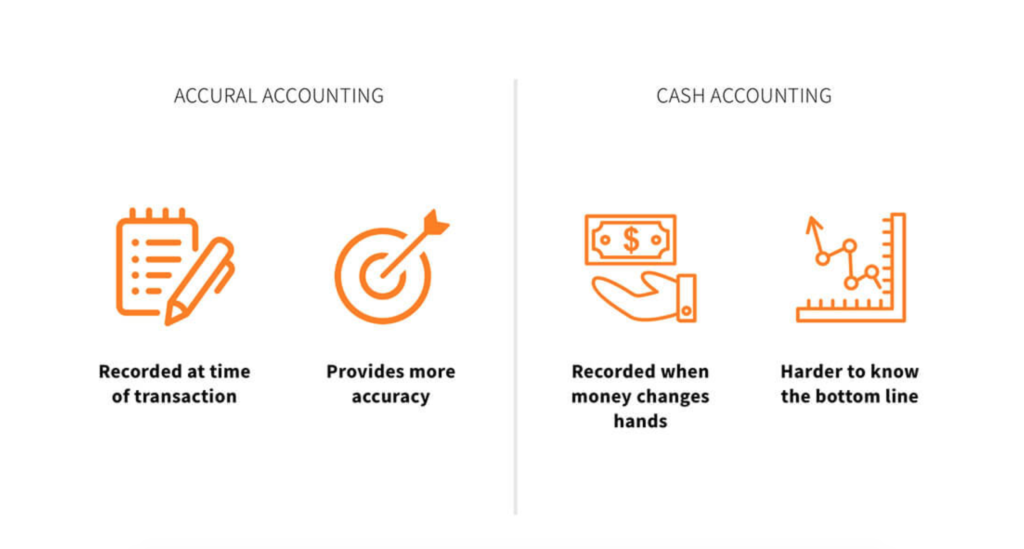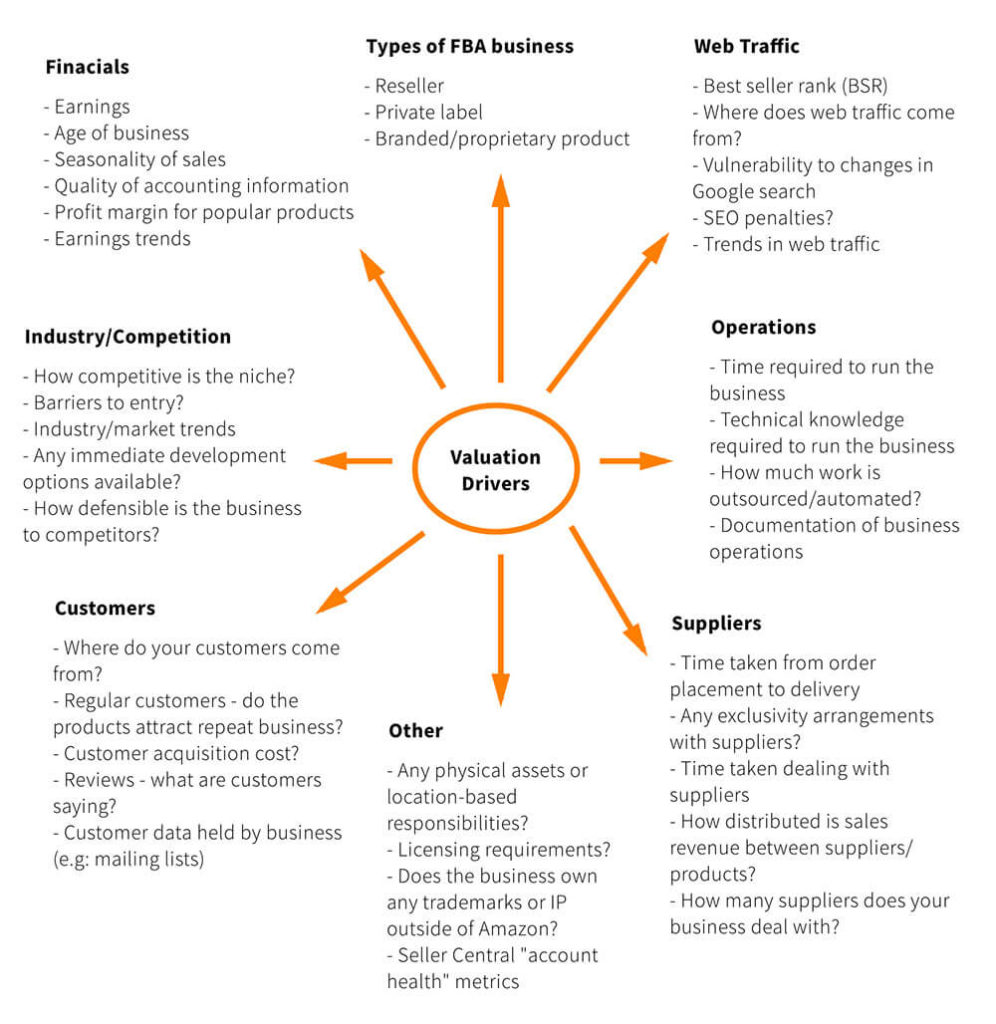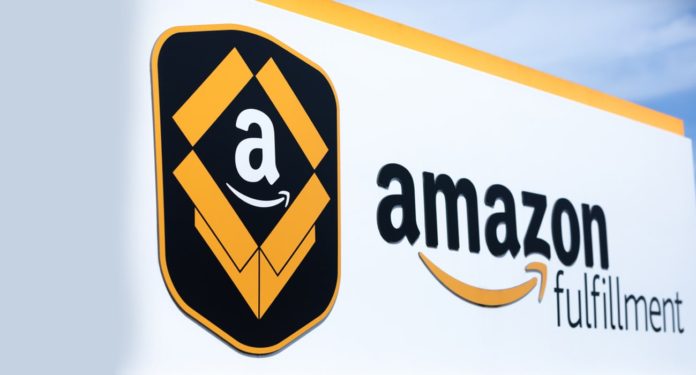Last Updated on June 26, 2019 by Shane Corbitt
Start at Part 1 of this 5 part series.
Amazon FBA businesses tend to be valued according to a multiple of gross earnings before tax, plus the cost of stock in Amazon warehouses (including the cost of getting stock into Amazon’s warehouses). For the purpose of valuations, the only expenses that are taken into account are the cost of goods sold, and necessary expenses required to run the business. A common industry term that refers to this earnings calculation is “Seller Discretionary Earnings” (SDE). Generally, valuation multiples are calculated based on annual SDE. However, for businesses that are in a rapid growth phase, or have been declining for the past 3-6 months, it can be useful to use a multiple of monthly SDE. Annual SDE takes more data into account, and provides a more reliable picture of the how the business is performing and growth trends moving into the future. Therefore, older businesses that use annual SDE tend to command a higher valuation multiple than newer businesses that are valued using monthly SDE.
When preparing accounts for tax and bookkeeping purposes, it is in your best interests to record any justifiable expense that reduces profit, as this results in less tax being paid. However, for the purpose of providing a valuation, the opposite of this rule applies. Buyers of FBA businesses have all different circumstances, and depending on their personal situation, they may or may not need to incur all expenses that you do. Costs such as owner’s salary, rent on offices, employees (where they are not absolutely necessary), insurances and vehicles should not be included in the SDE calculation.
When valuing your FBA business, you can use information from existing financial statements, and account for the expenses that are not absolutely necessary to continue running the business by using addbacks. An addback represents an expense that is not integral to your business operations.


To determine if you can record an expense as an addback, ask yourself “is this expense absolutely necessary to continue running the business?” Below are some examples of expenses that may be recorded as addbacks (depending on your specific situation):
- Interest on loans,
- Depreciation and amortization of assets,
- Owner’s salary,
- Meals and entertainment,
- Vehicle expenses,
- Rent on buildings (if those buildings aren’t absolutely necessary to operate the business),
- Web design and consultancy fees.
- Patent and trademark applications costs.
- Travel expenses (unless they are directly related to operating the business, e.g: visiting a supplier to inspect products),
- Mobile phones,
- Insurance,
- Charitable donations,
- Services that you don’t use anymore which have no impact on sales,
- Staff (if they aren’t absolutely necessary to run the business)
For a more detailed discussion on this topic, and an example of what addbacks look like in the profit and loss statement, refer to the first section “Step One: Why You Need Clean Financials” by Quiet Light Brokerage – Link here

Accrual accounting vs. cash accounting?
The two main ways that business accounts are handled (and therefore businesses are valued by) are accrual and cash accounting.


Cash accounting is a method where income and expenses are recorded when money changes hands: income is recorded when money is received, and expenses are recorded when bills are paid. Accrual accounting, on the other hand, records transactions when they occur: income is recorded when sales are made (or other income-generating activity occurs), and expenses are recorded when orders are placed or other expenses are incurred. Accrual accounting tends to provide a more accurate picture of the financial position of a business. We live in a credit-based world, where debts are often settled long after the fact. When valuing a business using the cash accounting method, sales income that has not yet been received is excluded from the income statement and profit figures (along with expenses that have not yet been paid). Oftentimes, the suppliers of Amazon businesses require payment upfront for goods supplied whilst Amazon pays FBA sellers every 14 days. Compared to the accrual accounting method, cash accounting tends to under-represent profit levels in an FBA business, thus reducing the valuation offered to potential buyers.
Accrual VS. Cash Accounting
It is important that your financials represent an accurate picture of where the business is at. However, working only with Amazon’s reporting in Seller Central is “extremely difficult and time consuming to reconcile accounts month to month whilst also including detail around fees, currency exchange costs, and other expenses” (Do your financials tell a story that sells). Dedicated accounting software for FBA businesses such as A2X makes this task a breeze. This is done by importing the correct data from Amazon, allocating income and expenses to the correct period, and automating the process of record keeping. By removing the potential for human error, potential buyers can be confident that accounts are more accurate and representative of the true state of the business.
What kind of earnings multiple can I expect to represent the value of my business?
Generally speaking, FBA businesses tend to be valued at around 2-3 times SDE. The valuation multiple can vary. Businesses without a unique offering, or sold with an immediate urgency for cash may fetch valuations closer to 0.5-1.5 times SDE, whereas businesses with a strong brand and unique, highly demanded proprietary products (or businesses that are ready to release new products with all research completed and/or enter new markets) may fetch valuation multiples above 3 times SDE.
So what factors have an effect on the valuation multiple? When valuing a business, there are many variables that can be taken into account. The following graphic provides more insight into the main valuation drivers:


At the end of the day, a business is only worth what a buyer is willing and able to pay for it. The more interested parties that are willing and able to buy the business, naturally, the more it is going to be worth.
Below, we will discuss each of the valuation drivers in a little more detail:
Financials
- Earnings – how much money is the business making (SDE)?
- Age of business – older, more established businesses tend to be more valuable than newer operations that have gained new customers very quickly.
- Earnings trends/seasonal factors – is 90% of revenue generated in a 3 month period? Or are sales made consistently throughout the year? Are there noticeable trends in business income?
- Businesses that receive a large portion of revenues from seasonal products (e.g: beach towels) are harder to manage in terms of cash flow and stock requirements, and they pose a higher risk of buying bad stock that needs to be dumped.
- How clean are the books? Are there any outliers in the figures? – clean, clear financials put buyers minds at ease, and make it easier to understand the true picture of the strengths and weaknesses of the business.
- Margins for each product – where does the profit come from? High margin, high volume is the best type of product to be selling. However, if one product with a very low margin represents a large proportion of sales, this might be a red flag for potential buyers.
- Trends in earnings – if a business is growing rapidly, the owner has little incentive to sell. If earnings growth is flat or declining, potential buyers have lots more bargaining power. The best time to sell is when earnings are steadily growing at a consistent pace. This represents stability and is valuable to potential buyers.
Type of FBA business? Businesses with strong brands and/or proprietary products are going to command a higher valuation multiple than private label businesses; private label businesses are going to command a higher valuation multiple than resellers. This is because more value is added, and the respective businesses market position and market share is more defensible as you move from one category of FBA business to the next.
Web Traffic
- Best seller rank (BSR) – this is a metric calculated hourly by Amazon. It takes many factors into account to calculate which items are selling the most, and based on the latest data, which items Amazon predicts to sell well in the future. The best seller rank is calculated for the marketplace overall, and for categories and subcategories. Products with BSRs that are gradually trending upwards indicate that the item is popular and exhibits stable growth.
- Products with high BSRs for their specific subcategory show that the product is selling very well compared to similar products on the market.
- The following points are related to FBA business that also have a website presence outside of Amazon
- Where does web traffic come from? Web traffic that is generated from organic search is more valuable than traffic generated from paid advertising. If people are searching directly for your brand, that is highly valuable.
- How vulnerable is the business to changes in Google’s search algorithms? If the website receives visitors from a number of different sources (e.g. direct visits, social media, referrals and clicking on links from blogs), then it can be said that the business is less reliant on people using Google search.
- Have there been any penalties (related to SEO) imposed on the business? If search engines such as Google deem that a website is trying to cheat to improve search rankings, then the search engine will impose penalties on the website. This makes it harder to get recognized in the future. Examples of actions which would result in a penalty include overusing keywords for the sake of recognition by search engine crawlers, plagiarizing content and doing things that the search engine deems to be misleading.
- Trends in web traffic – is the amount of visitors to your website growing or decreasing? What about visits from Google and clicks from social media? Growing visitor numbers is a good sign, declining visitor numbers is not.
Operations
- How much time is required each week to operate the business? Buyers of businesses want to acquire an income stream and a share of the niche market in which you operate, not a full time job. The less work required, the better.
- Technical knowledge required to run the business: do you need any specific skills or knowledge in order to operate the business? The best type of business to buy is one where the purchaser can hit the ground running without needing to do too much research to succeed. However, requiring technical knowledge is not necessarily always a bad thing – it can represent a barrier to entry which can help to deter competition. If operating a business in your niche requires a lot of technical knowledge, you will have a smaller pool of potential buyers.
- What is outsourced? What is done by the owner? Are there any employees of the business? In the world of FBA businesses, outsourcing and automation is king. Employees can represent work to manage; the less work required by the owner, the better!
- How well documented are the operations of the business? Looking from the perspective of a potential buyer, a business with great documentation shows that things are in order; it provides a guided path for most scenarios, and makes life a whole lot easier if something goes wrong. Compare this to a business with no formal documentation where the knowledge of operations exists solely in the owner’s brain – which one would you rather buy?
Industry/competition
- How competitive is the niche? The less competition, the better. However, if a business is dominating a highly competitive niche, this can represent significant value if that market share is defensible through unique products or exclusive supply arrangements.
- Barriers to entry? How easy is it for new companies to set up and compete with your business? How easy would it be for potential buyers to compete with you instead of purchasing your business?
- Industry/market trends? Is the market growing? Is it steady? Is the market declining?
- Are there any immediate development/expansion options available? Buyers are in it for the money. If you can offer a ‘carrot’ in the way of immediate business expansion potential, this can make the business much easier to sell, and potentially fetch a higher valuation. Examples of this would be researching and preparing a few new products that fill gaps in the market which can be launched immediately following the sale of the business, or maybe researching new markets that can be easily expanded into by the new owners.
- The key theme here is how defensible is the business – buyers don’t want to inherit a business that could be destroyed tomorrow. They are purchasing a going concern and want to see stability and growth!
Customers
- Where do the customers come from?
Are all of the customers from one state or country? Or are they spread throughout the world? Are all of the sales made through Amazon, or is revenue also generated elsewhere? Can you describe your typical customer? The more diversified the income streams of your business are, the better. - Do customers tend to come back for more, or just make one-off purchases? Repeat customers represent lots more value.
- If your business caters more towards repeat customers, do you know what the customer acquisition cost is? What about the customer lifetime value? This can be very useful in planning appropriate marketing budgets and potentially developing loyalty schemes.
- How good are your reviews? Products with good reviews attract far more customers than products that seldom get reviewed, or have bad reviews. It’s a self-reinforcing cycle.
- What customer information is available for further marketing efforts? Do you have a customer mailing list or social media presence? This can be useful for re-marketing to the existing audience; if you have this kind of information, make sure to promote it to potential buyers.
Suppliers
- Lead times – you need stock to sell. How long does it take for suppliers to replenish your stocks when you reorder? If there are long lead times, are suppliers willing to store stock in their warehouses on your behalf?
- Exclusivity – if you have contracts in place to ensure that you have exclusive access to a popular product or range, this can be very valuable to potential buyers (as long as the supplier is willing to continue to honour the contract under new ownership).
- How much time is required to deal with your suppliers? Do you have any processes in place to reduce the workload associated with dealing with suppliers? Again, systems are key here – the less work required, the better. If you can outsource or automate dealings with suppliers, even better!
- Is the sales revenue skewed heavily towards a particular product or supplier? This is important to consider, as many FBA businesses offer a wide range of products but gain the majority of their sales from only a few product lines.
- How many suppliers does the business deal with? If the business deals with too many suppliers, it can represent lots of work managing all of these relationships. If the business only has one supplier, then there is potential for the suppliers to go out of business or reduce their quality of products or service which has flow on effects to your business. Of course, relationships are key here, and one proactive, dependable top-quality supplier that offers generous terms is far more valuable than 10 average quality suppliers.
==> Follow this link to Part 3 of this series in selling your FBA business. <==










